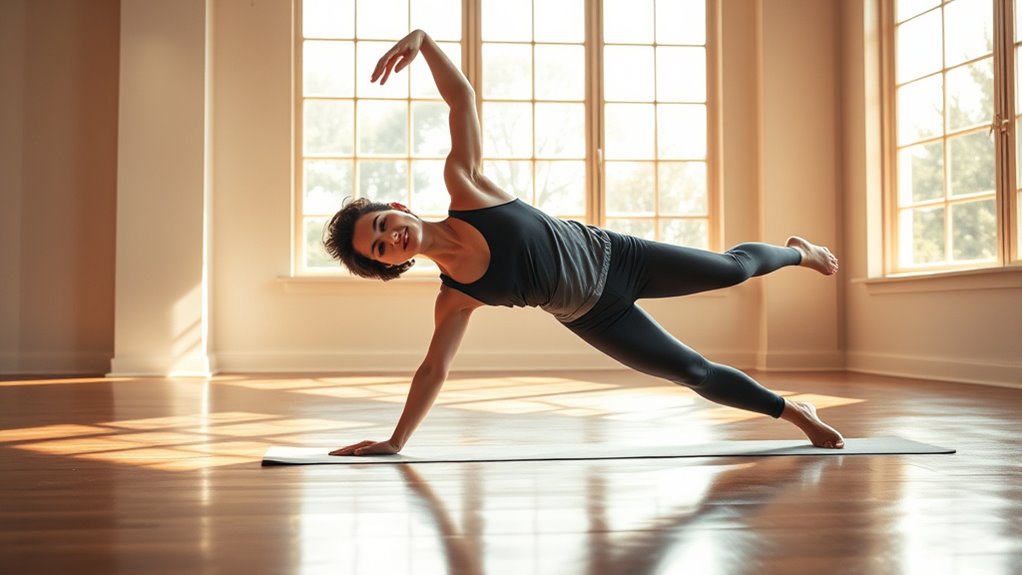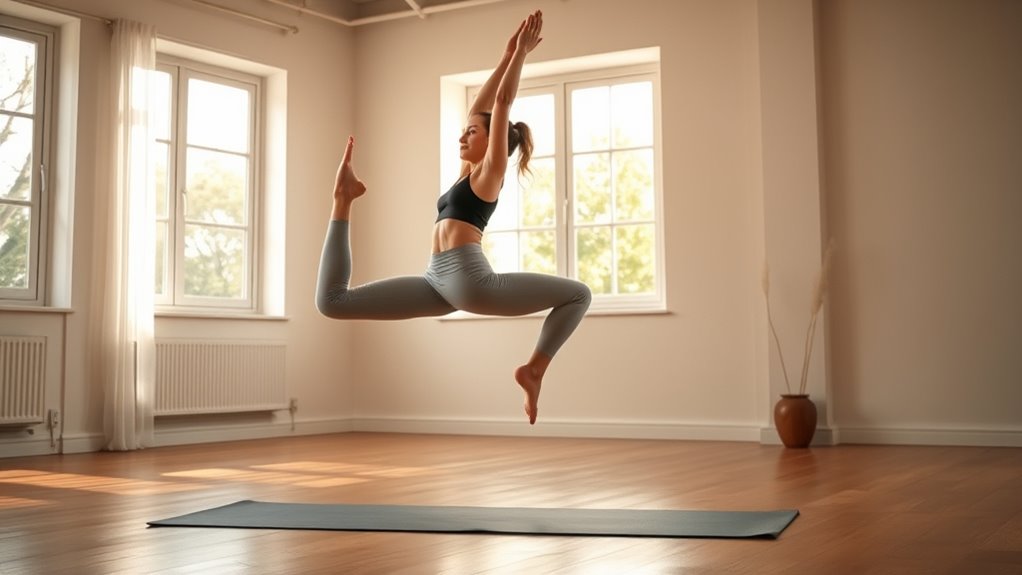To level up your yoga practice, start exploring advanced moves that challenge your strength, flexibility, and mental focus. Incorporate deep, controlled breathing to stay centered and boost your stability during complex poses like Crow or arm balances. Use meditation techniques to calm your mind and improve your focus, making challenging passages smoother. With consistent effort and patience, you’ll open new physical and mental heights. Keep going further to discover even more ways to elevate your practice.
Key Takeaways
- Incorporate advanced poses gradually to build strength and flexibility safely.
- Use controlled, deep breathing to improve stability and focus during complex movements.
- Combine meditation techniques to enhance mental clarity and maintain concentration.
- Focus on slow, deliberate transitions to master form and prevent injury.
- Practice patience and consistency to progressively elevate your yoga practice.

Even if you’re new to yoga, exploring advanced moves can be both exciting and rewarding as you build strength and flexibility. Moving into more challenging poses pushes your limits, but it also deepens your practice and helps you discover new levels of mental clarity. One of the key elements in mastering these advanced moves is breath control. As you progress, you’ll notice that your ability to manage your breath directly impacts your stability and energy levels during complex poses. Mastering breath control involves intentionally slowing down and deepening your inhales and exhales, which helps maintain focus and keeps your muscles engaged without strain. This increased awareness of your breathing not only improves your physical performance but also enhances your meditation techniques, allowing you to stay present and centered even in demanding postures. Incorporating protective styling benefits into your awareness can support safer practice and help prevent injury.
Master breath control to enhance stability, focus, and deepen your advanced yoga practice.
When practicing these advanced yoga moves, integrating meditation techniques becomes essential. Meditation helps calm your mind, creating a mental space that supports physical effort. As you hold challenging poses, use meditation techniques like focused breathing or body scans to maintain concentration and prevent distraction. This mental clarity reduces the likelihood of injury and allows you to push through difficult moments with patience and resilience. Incorporating mindfulness into your practice helps you recognize your body’s signals, encouraging proper alignment and avoiding overexertion. The combination of breath control and meditation techniques cultivates a sense of inner calm, making even the most complex poses feel more manageable.
To deepen your practice, focus on slow, deliberate movements that emphasize breath synchronization. For example, entering a pose like Crow Pose (Bakasana) requires not only strength but also controlled breathing to maintain balance. As you lift into the pose, inhale deeply, then exhale slowly as you stabilize. Use your breath to center yourself, and if your mind starts to wander, gently bring your focus back to your breath. Over time, this practice becomes second nature, allowing you to hold advanced poses longer with greater ease. Remember, advanced yoga isn’t just about physical mastery; it’s about cultivating mental discipline through breath control and meditation techniques. These tools help you stay grounded, focused, and resilient as you challenge yourself physically.
Incorporating these elements into your practice transforms advanced yoga from a physical challenge into a holistic experience. You’ll find that your strength and flexibility improve, but so does your mental clarity and emotional stability. Keep practicing patience and consistency, and you’ll discover that the journey into advanced yoga moves is as much about inner growth as it is about physical achievement.
Frequently Asked Questions
How Can I Prevent Injuries When Attempting Advanced Yoga Poses?
To prevent injuries when trying advanced yoga poses, focus on proper alignment cues and listen to your body. Use alignment cues to maintain correct positioning, reducing strain. Incorporate breathing techniques to stay relaxed and centered, which helps avoid overstretching or forcing poses. Progress gradually, avoiding pushing into pain. By combining mindful alignment and controlled breathing, you’ll build strength safely and enjoy the benefits of advanced yoga without risking injury.
What Is the Ideal Progression to Reach Advanced Yoga Moves Safely?
To reach advanced yoga moves safely, focus on a gradual progression that emphasizes proper pose alignment and mastering foundational poses first. Incorporate mindful breathing techniques to build strength and stability. Listen to your body, avoid rushing, and seek guidance from experienced instructors. Consistently practice, refine your alignment, and deepen your breath control. This approach guarantees a safe, effective journey toward more complex poses, minimizing injury risk and enhancing your overall practice.
Are There Specific Warm-Up Routines Recommended Before Advanced Poses?
Imagine you’re prepping for a secret mission—warm-up matters! Before advanced yoga poses, you should do dynamic stretches to loosen muscles and enhance flexibility. Gentle activation of key muscle groups prepares your body without overexertion. Focus on deep breathing, arm circles, and hip openers, gradually increasing intensity. This routine primes your body, reduces injury risk, and helps you flow seamlessly into complex poses, making your practice safer and more effective.
How Do I Modify Advanced Poses for Limited Flexibility or Strength?
When modifying advanced poses for limited flexibility or strength, you should use props and modifications to stay safe and comfortable. Props like blocks, straps, or blankets provide support, while alternative poses help you achieve similar benefits without overstretching or straining. Focus on listening to your body and adjusting poses accordingly, gradually building strength and flexibility over time. Remember, consistent practice and patience are key to progressing safely.
What Mental Preparations Are Helpful for Mastering Complex Yoga Sequences?
To master complex yoga sequences, you should focus on mental preparations like mindfulness practices and visualization techniques. Stay present in each movement, releasing distractions and cultivating focus. Visualize yourself successfully completing challenging poses, building confidence and mental resilience. Regularly practicing mindfulness helps you stay calm and centered, making it easier to progress. These mental strategies enhance your concentration, allowing you to approach advanced poses with clarity and determination.
Conclusion
So, now that you’ve tackled these advanced moves, get ready to impress your friends—and maybe even your cat—who’s been judging your downward dog from afar. With a little practice, you’ll be contorting yourself into pretzel-like shapes, making even the most seasoned yogis say, “Whoa.” Just remember, yoga isn’t about perfect poses; it’s about embracing your inner contortionist and keeping your ego as flexible as your hamstrings. Namaste, or whatever.









